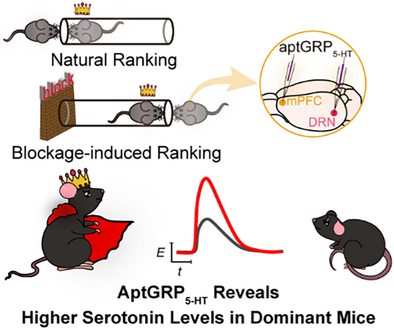Aptamer-Based Galvanic Potentiometric Sensor for Real-Time Monitoring of Serotonin Signaling Under Psychosocial Stress
Graphical Abstract
A phosphorothioate aptamer-based galvanic redox potentiometric sensor (aptGRP5-HT) with enhanced sensitivity and selectivity enables real-time monitoring of serotonin in a mouse model of psychosocial stress. It reveals, for the first time, a distinct correlation between serotonin release and social hierarchy, with higher serotonin levels in dominant mice.
Abstract
Psychosocial stress, a pervasive factor in mental health disorders, is tightly linked to serotonin (5-HT) dysregulation. Real-time electrochemical monitoring of 5-HT in vivo is challenged by interference from vitamin C (Vc) and biofouling, requiring invasive pretreatments. We present a self-powered aptamer-engineered galvanic sensor (aptGRP5-HT) that integrates phosphorothioate aptamers with a redox potentiometric mechanism, achieving 21.5-fold higher selectivity and 98.3-fold enhanced sensitivity against Vc over conventional sensors while resisting electrochemical biofouling. The aptGRP5-HT operates in complex biological environments without pretreatment, enabling direct monitoring in a rodent psychosocial stress model. Using this tool, we uncover a neurochemical signature of social hierarchy: high-ranking mice exhibit elevated 5-HT release in the medial prefrontal cortex (mPFC) and dorsal raphe nucleus (DRN), with region-specific correlations to neuronal activity-reduced spontaneous firing in the mPFC and increased activity in the DRN. This work resolves long-standing challenges in neurochemical sensing and establishes aptGRP5-HT as a transformative platform for probing brain function and stress-related disorders.
Conflict of Interests
The authors declare no conflict of interest.
Open Research
Data Availability Statement
The data that support the findings of this study are available from the corresponding author upon reasonable request.





